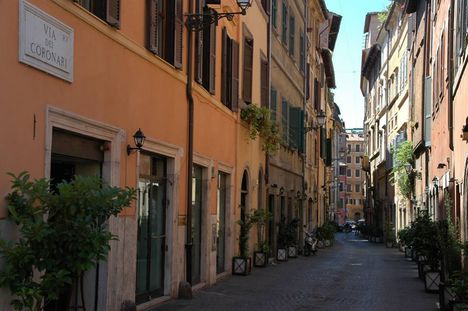way of the Coronary
Way of the Coronary showed up , from the beginning , as a path of high interest , identifying the ancient Via Recta , which connected the Via Lata with the Neronian Bridge , which collapsed at the end of the fourth century . The way Recta in the Middle Ages it was called " Tor Blood " for its proximity to this tower and then " of the Coronary " by the sellers of wreaths and sacred objects are also called " paternostrari " , who had established their business here because the path used by pilgrims who went to St. Peter. Way of the Coronary was opened by Pope Sixtus IV della Rovere and was the first straight road axis within the maze of narrow streets of the medieval city. About 500 meters long , in the Renaissance was divided into two sections , one called " Picture of the Bridge" , newsstand sacred rebuilt in the sixteenth century by Sangallo and the other " Scortecchiaria " because it crossed the district of tanners . Three aspects of this that can be considered one of the most beautiful streets of Rome: the medieval , preserved in the alleys , the renaissance of the houses around the square Montevecchio and Montegiordano and finally the spectacular baroque whose expression is made up of the most extraordinary church of St. Our Lady of Peace , designed by Pietro da Cortona.
In this area all still speaks of the great traffic of pilgrims who thronged in every season, especially during the jubilees : the newsstands , the houses of the various confraternities, neighboring churches . Today, in this world there is almost no trace , leaving only the architectural remains , mute witnesses of reality and a popular culture of the past: the road has preserved its Renaissance character , interrupted only by some demolitions around 1939 Vecchierelli palace and the creation of open spaces to the left of S. Salvatore in Lauro and in front of Palazzo Lancellotti .
Way of the Coronary is famous for its antique shops to the glittering shop windows full of furniture from every era , lamps , tables, desks, practically a permanent exhibition .
Palazzo Bonaventura , at number 28 , was built towards the end of the fifteenth century , and its Renaissance origin is most evident in the harmonious facade , divided into travertine pilasters with Corinthian capitals and in the courtyard arcade of columns. The building , situated on the Piazza di S. Simeon is composed of a facade made entirely of brick two-storey , each with four windows. On the ground floor , plus a few doors of the shops , the portal opens , the upper floors , divided by the simple, elegant string courses of travertine, are clamped vertically in travertine pilasters with Corinthian capitals . Within the frames resulting setting the windows, four on each floor , those on the first floor are travertine , while the upper ones are simply framed by an exhibition ever in travertine.


















Kommentáld!